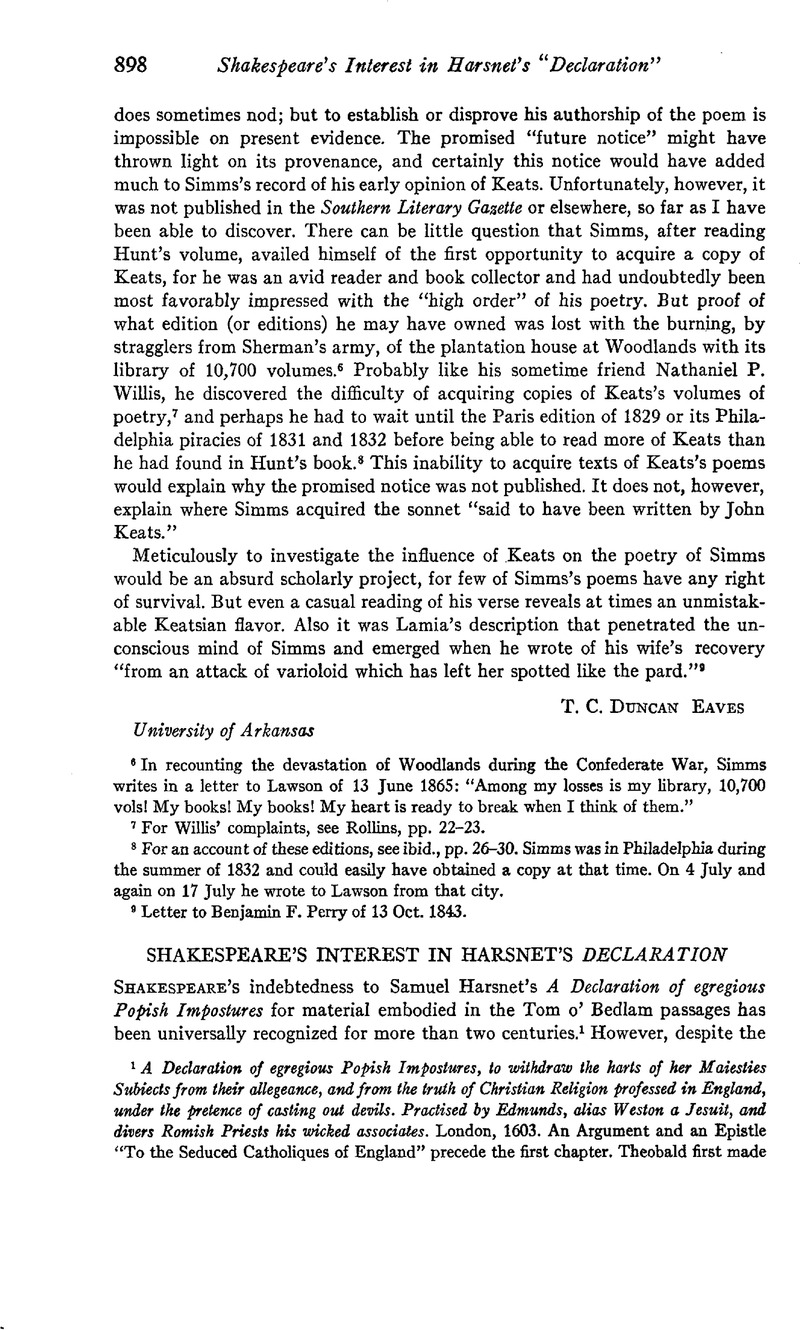No CrossRef data available.
Article contents
Shakespeare's Interest in Harsnet's Declaration
Published online by Cambridge University Press: 02 December 2020
Abstract

Information
- Type
- Notes, Documents, and Critical Comment
- Information
- Copyright
- Copyright © Modern Language Association of America, 1952
References
1 A Declaration of egregious Popish Impostures, to withdraw the harts of her Maiesties Subiects from their allegeance, and from the truth of Christian Religion professed in England, under the pretence of casting out demis. Practised by Edmunds, alias Weston a Jesuit, and divers Romish Priests his wicked associates. London, 1603. An Argument and an Epistle “To the Seduced Catholiques of England” precede the first chapter. Theobald first made the discovery of Shakespeare's debt, publishing his discovery in the 1733 edition of King Lear. Warburton in 1747 enlarged upon Theobald's note, and Johnson and Steevens later in the century added further instances of Shakespeare's borrowings from Harsnet. Malone went further than any other eighteenth-century editor in adducing concrete proofs of Shakespeare's indebtedness. “He has used the very words” of Harsnet's Declaration, Malone observed (The Plays and Poems, 1790, viii, 589, n. 2). Malone listed eight specific locations in the Declaration where he found instances of Shakespeare's borrowings. See also Kenneth Muir, “Samuel Harsnett and King Lear,” RES, ii (Jan. 1951), 21.
2 Declaration, pp. 47, 49, 136, 194-195, 225, 268, 278. (See Malone, viii, 597, n. 6; 594, n. 9; 619, n. 3; 603, n. 5; 603, n. 5; 597, n. 8; 619, n. 2; for discussion of each specific borrowing in seriatim order.)
3 Fray Diego de Yepes was Philip II's confessor. His work has never been translated, and thus far seems to have eluded the scholarly attention it manifestly deserves. Yepes stated Debdale's exorcisms were a means of reconciling hundreds to the church (p. 97; cf. p. 898).
4 At the time of his execution she still had a purse of gold of his intended for this purpose (p. 205).
5 At the time of writing his exposé Harsnet was chaplain to Bishop Bancroft of London. After Bancroft's elevation to the Archbishopric of Canterbury the ensuing year (1604) Harsnet made steady ecclesiastical progress; he became bishop of Chichester the year before Bancroft's death. During Charles I's reign he was made Archbishop of York.
6 For a list of Catholic objections to the Declaration see Richard Challoner, Memoirs ... (London, 1741), i, 186.
7 Among them were the following: Harsnet's own 1599 A Discovery of the Fraudulent practises of John. Darrel... concerning the pretended possession and dispossession, of William Somers ... detecting in some sort the deceitfull trade in these latter dayes of casting out Devils; John Darrel's 1599 The Triall of Maist. Dorrell... To cleare him from the Imputation of teaching ... counterfeit possession of Divells; Darrel's 1600 A True Narration of the Strange and Grevous Vexation by the Devil, of 7. persons in Lancashire; John Deacon and John Walker's 1601 Dialogicall Discourses of Spirits and Divels, Declaring their proper essence, natures, dispositions, and operations: their possessions and dispossessions; and, of course, King James's 1603 Daemonologie (issued as a reprint of the 1597 Edinburgh original).
8 E. I. Fripp, Shakespeare: Man and Artist (London, 1938), p. 180. Robert Debdale's birthdate has been disputed. In 1579, according to the Douay Diaries (London, 1878, p. 159), he was adolescens. He had already before 1579 spent time in Rome as a student of theology, returning from Rome to Rheims in the company of William Kestel.
9 T. W. Baldwin, William Shakspere's Small Latine and Lesse Greek (Urbana, Ill., 1944), i, 482-483.
10 This letter (quoted by Fripp) read in part: “commending unto you my especiall ffriend Mr. Cottame, who hathe bene vnto me the to halfe of my lyfe. I cannot sufficiently commend vnto you his loving kyndnesse showed and bestowed vppon me. Wherefore I beseche you to take consayle of hyme in matters of great wayt.”
11 Fripp, Shakespeare's Haunts (London, 1929), p. 30.
12 J. H. Pollen, “A Shakespeare Discovery,” The Month, Nov. 1917.

